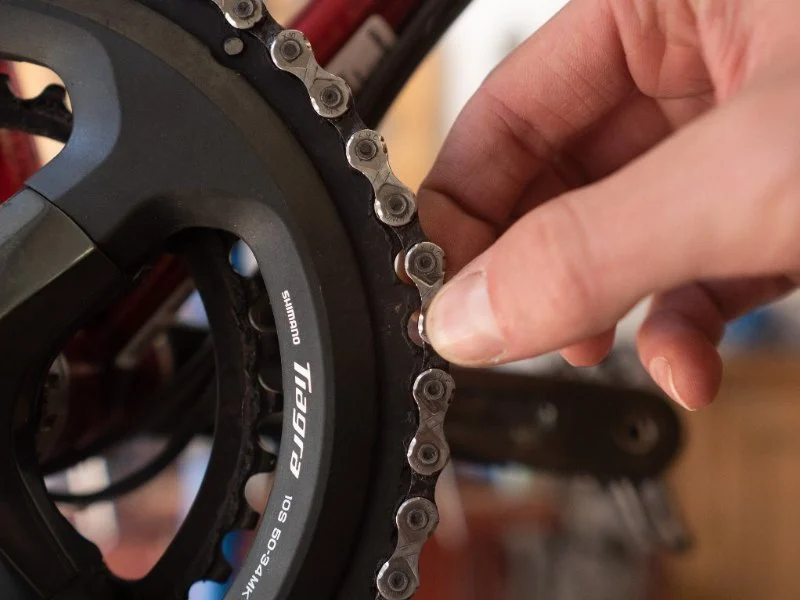
- 1. Understanding Bike Chain Wear
- 2. Why Bike Chain Maintenance Is Important
- 3. How to Check If Your Bike Chain Needs Replacing
- 4. Tools Needed to Check Your Bike Chain
- 5. Signs Your Bike Chain Needs Replacing
- 6. How to Extend the Life of Your Bike Chain
- 7. Where to Buy a New Bike Chain
1. Understanding Bike Chain Wear
Over time, the bike chain undergoes wear and tear due to the constant friction between the chain and the gears. This wear happens gradually, and while it might seem subtle at first, it can lead to significant issues if not addressed. A worn-out chain can affect your bike’s performance, making pedaling less efficient and causing premature wear on other components like the cassette and chainrings.
When a bike chain wears, it starts to stretch and elongate, causing the links to lose their precise fit with the gears. This causes skipping, poor shifting performance, and eventually, can lead to the chain slipping or even breaking. Identifying when your bike chain needs replacing is essential to maintaining the overall health of your bike and avoiding costly repairs down the road.
2. Why Bike Chain Maintenance Is Important
Proper maintenance of your bike chain not only extends its life but also ensures your overall cycling experience remains smooth and efficient. Regularly checking your bike chain can help prevent issues like:
1. Poor Shifting Performance
A worn chain causes poor shifting, making it harder to change gears smoothly. It can also cause skipping, where the chain doesn't engage properly with the gears, leading to a jerky ride.
2. Increased Wear on Other Components
If your chain is worn out, it will put more strain on the cassette and chainrings. This can lead to premature wear on these parts, ultimately leading to more expensive repairs and replacements.
3. Decreased Pedaling Efficiency
A chain that’s too stretched or worn out can result in inefficient power transfer from your legs to the wheels. This means you’re expending more energy for the same amount of effort, which can make cycling less enjoyable and more tiring.
3. How to Check If Your Bike Chain Needs Replacing
To know when it’s time to replace your bike chain, there are several simple methods you can use to check for wear. Below are a few ways to determine if your chain needs replacing:
1. Measure the Chain’s Length (Chain Stretch)
One of the most common methods of checking chain wear is by measuring its length. Over time, the chain elongates due to wear. You can use a chain checker tool, which measures the elongation in percentage. A chain with more than 0.5% elongation should be replaced, while chains with 1.0% or more elongation can cause significant damage to other components if not replaced.
2. Check for Skipping or Slipping
If you notice that your bike chain skips or slips during pedaling, it’s a clear sign that it’s no longer engaging properly with the gears. This is a result of the chain being too stretched to fit correctly, causing it to jump over teeth on the chainrings or cassette.
3. Inspect the Chain for Visible Damage
Another simple way to check for chain wear is to inspect it visually. Look for any visible signs of damage such as bent links, rust, or cracks. Any of these issues can compromise the performance of your chain and indicate that it’s time for a replacement.
4. Tools Needed to Check Your Bike Chain
To accurately assess your bike chain’s condition, you’ll need a few tools:
1. Chain Checker Tool
This tool is designed specifically to measure chain wear and elongation. It’s a quick and easy way to determine how much the chain has stretched and whether it’s time for a replacement.
2. Ruler or Tape Measure
If you don’t have a chain checker tool, a ruler or tape measure can be used to measure the distance between specific links and compare it to the original chain length. This can give you a rough idea of how much the chain has stretched over time.
3. Bike Stand or Workbench
For a more thorough inspection, it’s helpful to have a bike stand or a stable workbench to keep your bike upright while you inspect the chain and test its performance.
5. Signs Your Bike Chain Needs Replacing
Here are some common signs that your bike chain may need replacing:
1. Visible Wear
If your chain shows signs of wear such as rust, cracks, or kinks, it’s time to replace it. A worn chain can lead to issues like slipping, skipping, and poor shifting performance.
2. Poor Shifting Performance
If you notice that your bike is having difficulty shifting gears or the gears are skipping, it could be a sign that your chain is worn and no longer fitting properly with your cassette or chainrings.
3. Noise While Pedaling
Excessive noise when pedaling, especially in the form of squeaks or grinding, can indicate that your chain is worn and needs replacement. The chain may not be sitting smoothly in the teeth of the cassette or chainrings.
6. How to Extend the Life of Your Bike Chain
Maintaining your bike chain can extend its lifespan and keep it performing optimally for longer. Here are some tips:
1. Regular Cleaning
Clean your chain regularly to remove dirt, grease, and debris that can cause premature wear. Use a degreaser and a brush to clean the chain, and apply fresh lubricant afterward to reduce friction.
2. Lubricate the Chain
Apply chain lubricant to prevent rust and reduce friction between the chain and gears. Be sure to wipe off excess lubricant to avoid attracting dirt.
3. Check the Chain Tension
Make sure your chain is properly tensioned. Too tight or too loose a chain can cause additional stress on the components, leading to faster wear.
7. Where to Buy a New Bike Chain
If it’s time to replace your bike chain, you can find high-quality replacements at Cycling Guider. Whether you need a standard chain or one tailored to your specific bike model, Cycling Guider offers a wide range of options to suit your needs. They provide a selection of trusted brands and expert recommendations to help you choose the best chain for your bike. Visit their website to browse their collection and find the right chain for your ride.







 Cascade Bikes4.0 (211 reviews)
Cascade Bikes4.0 (211 reviews) Bike Mart4.0 (2281 reviews)
Bike Mart4.0 (2281 reviews) EMPowered Cycles Electric Bikes4.0 (38 reviews)
EMPowered Cycles Electric Bikes4.0 (38 reviews) Chain Lube5.0 (1 reviews)
Chain Lube5.0 (1 reviews) Global Bikes & E-Bikes4.0 (651 reviews)
Global Bikes & E-Bikes4.0 (651 reviews) Trek Bicycle Stuyvesant Town4.0 (254 reviews)
Trek Bicycle Stuyvesant Town4.0 (254 reviews) How to Teach Kids to Ride a Bike: A Step-by-Step Guide for Parents
How to Teach Kids to Ride a Bike: A Step-by-Step Guide for Parents Tips for Riding on Busy City Streets: Smart Strategies for Urban Cyclists
Tips for Riding on Busy City Streets: Smart Strategies for Urban Cyclists Best US National Parks for Mountain Biking: Ride Epic Trails Across America
Best US National Parks for Mountain Biking: Ride Epic Trails Across America Best Aero Helmets for Time Trials and Racing
Best Aero Helmets for Time Trials and Racing How to Clean and Lubricate Your Bike Chain Like a Pro
How to Clean and Lubricate Your Bike Chain Like a Pro 10 Must-Have Items for Long-Distance Cycling Trips
10 Must-Have Items for Long-Distance Cycling Trips